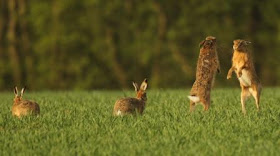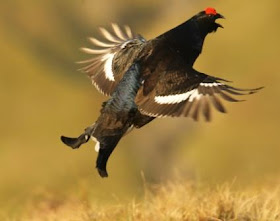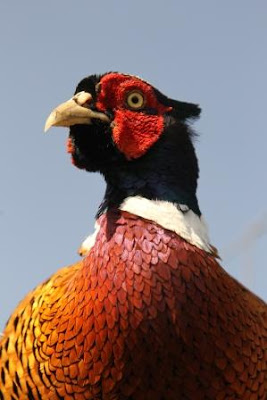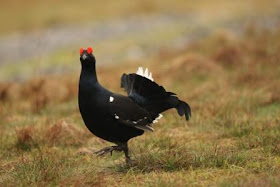Monday, May 30, 2011
Originals Catalogue
My exhibition starts on Saturday (4th June), so I thought you might like to have a sneak preview of the originals that are going to be on display! I've got finishing touches to do this week to two final paintings one of a red stag and one of a little owl and then I should just have enough time left to tidy my studio before I open the gallery doors...
Saturday, May 28, 2011
Badger Cubs
There are three badger cubs at the sett by my badger hide this year.
 It's so good to see them after last year when there were no cubs there at all.
It's so good to see them after last year when there were no cubs there at all.
 This year the clan is made up of just five adults and the whole sett is much calmer than it was two years ago when there were nine adults. At that time tensions were running high and fights would break often break out.
This year the clan is made up of just five adults and the whole sett is much calmer than it was two years ago when there were nine adults. At that time tensions were running high and fights would break often break out.
 Already the badgers are getting more adventurous. Badgers start emerging from their underground chambers shortly after 8pm, whilst it is still quite light.
Already the badgers are getting more adventurous. Badgers start emerging from their underground chambers shortly after 8pm, whilst it is still quite light.
 The sow pictured above with her cub is only two years old. The badgers begin to get more confident after 9pm when the light begins to fade. I have to start using a flash at this point to be able to photograph them.
The sow pictured above with her cub is only two years old. The badgers begin to get more confident after 9pm when the light begins to fade. I have to start using a flash at this point to be able to photograph them.
 This is the largest of the cubs. I think he is a male.
This is the largest of the cubs. I think he is a male.
 I put food in this hollow log thinking it would make a good photographic opportunity.
I put food in this hollow log thinking it would make a good photographic opportunity.
 It really is a delight to watch these new youngsters as they explore their new surroundings.
It really is a delight to watch these new youngsters as they explore their new surroundings.

 It's so good to see them after last year when there were no cubs there at all.
It's so good to see them after last year when there were no cubs there at all. This year the clan is made up of just five adults and the whole sett is much calmer than it was two years ago when there were nine adults. At that time tensions were running high and fights would break often break out.
This year the clan is made up of just five adults and the whole sett is much calmer than it was two years ago when there were nine adults. At that time tensions were running high and fights would break often break out. Already the badgers are getting more adventurous. Badgers start emerging from their underground chambers shortly after 8pm, whilst it is still quite light.
Already the badgers are getting more adventurous. Badgers start emerging from their underground chambers shortly after 8pm, whilst it is still quite light. The sow pictured above with her cub is only two years old. The badgers begin to get more confident after 9pm when the light begins to fade. I have to start using a flash at this point to be able to photograph them.
The sow pictured above with her cub is only two years old. The badgers begin to get more confident after 9pm when the light begins to fade. I have to start using a flash at this point to be able to photograph them. This is the largest of the cubs. I think he is a male.
This is the largest of the cubs. I think he is a male. I put food in this hollow log thinking it would make a good photographic opportunity.
I put food in this hollow log thinking it would make a good photographic opportunity. It really is a delight to watch these new youngsters as they explore their new surroundings.
It really is a delight to watch these new youngsters as they explore their new surroundings.
Thursday, May 19, 2011
Boxing Hares
I watched these hares box the other day.

 I first spotted a group together in a field.
I first spotted a group together in a field. 


 I first spotted a group together in a field.
I first spotted a group together in a field. 
The there was a female in season and she had attracted a large gathering of males.
 I watched for about half an hour before they sped off across the field in pursuit of this female.
I watched for about half an hour before they sped off across the field in pursuit of this female.

 You can see this female is surrounded by males.
You can see this female is surrounded by males.
 I watched for about half an hour before they sped off across the field in pursuit of this female.
I watched for about half an hour before they sped off across the field in pursuit of this female. 
 You can see this female is surrounded by males.
You can see this female is surrounded by males.
I will be focusing on hares for my next exhibition which runs from June 4th - 19th and have just finished this painting for it: 

Wednesday, May 18, 2011
Black Grouse Lek
The black grouse lek is one of the most remarkable courtship displays that you can see in this country: more reminiscent of a tropical bird dance than that of an English grouse.
 I spent a week last month waking before dawn so that I could photograph this incredible event on the Yorkshire Dales.
I spent a week last month waking before dawn so that I could photograph this incredible event on the Yorkshire Dales.  On most days the weather was against me and from my hide on top of the windswept moors I was unable to get photographs good enough to paint from.
On most days the weather was against me and from my hide on top of the windswept moors I was unable to get photographs good enough to paint from.
 But thankfully on the last day the sun came up and I got some shots to be proud of.
But thankfully on the last day the sun came up and I got some shots to be proud of.

 The black grouse males circle with their tail feathers fanned and then every so often leap up into the air calling out.
The black grouse males circle with their tail feathers fanned and then every so often leap up into the air calling out.  Meanwhile the females saunter nonchalantly through the middle of the commotion, causing the males to whirr about even more excitedly.
Meanwhile the females saunter nonchalantly through the middle of the commotion, causing the males to whirr about even more excitedly.
Click here to read my latest column in The Yorkshire Post on how I went about photographing the lekking grouse.
 I spent a week last month waking before dawn so that I could photograph this incredible event on the Yorkshire Dales.
I spent a week last month waking before dawn so that I could photograph this incredible event on the Yorkshire Dales.  On most days the weather was against me and from my hide on top of the windswept moors I was unable to get photographs good enough to paint from.
On most days the weather was against me and from my hide on top of the windswept moors I was unable to get photographs good enough to paint from. But thankfully on the last day the sun came up and I got some shots to be proud of.
But thankfully on the last day the sun came up and I got some shots to be proud of.

 The black grouse males circle with their tail feathers fanned and then every so often leap up into the air calling out.
The black grouse males circle with their tail feathers fanned and then every so often leap up into the air calling out.  Meanwhile the females saunter nonchalantly through the middle of the commotion, causing the males to whirr about even more excitedly.
Meanwhile the females saunter nonchalantly through the middle of the commotion, causing the males to whirr about even more excitedly.Occasionally the cocks also spar.
Click here to read my latest column in The Yorkshire Post on how I went about photographing the lekking grouse.
Thursday, May 12, 2011
Kamikaze Pheasant
You may remember the pheasant that was attacking villagers in Newsham in North Yorkshire last year. I came across a similarly vicious bird in the Dales. I was driving along a moor late one evening when it rushed out into the middle of the road in an attempt to cut me off.
I came across a similarly vicious bird in the Dales. I was driving along a moor late one evening when it rushed out into the middle of the road in an attempt to cut me off.
 This cock bird was highly territorial and wanted me off his patch. I decided I ought to try and get it off the road before it got run over.
This cock bird was highly territorial and wanted me off his patch. I decided I ought to try and get it off the road before it got run over.
 But when I got out of the car with my camera he rushed at me, pecking and sparring my arm.
But when I got out of the car with my camera he rushed at me, pecking and sparring my arm.
It really hurt.
 I came across a similarly vicious bird in the Dales. I was driving along a moor late one evening when it rushed out into the middle of the road in an attempt to cut me off.
I came across a similarly vicious bird in the Dales. I was driving along a moor late one evening when it rushed out into the middle of the road in an attempt to cut me off. This cock bird was highly territorial and wanted me off his patch. I decided I ought to try and get it off the road before it got run over.
This cock bird was highly territorial and wanted me off his patch. I decided I ought to try and get it off the road before it got run over. But when I got out of the car with my camera he rushed at me, pecking and sparring my arm.
But when I got out of the car with my camera he rushed at me, pecking and sparring my arm.It really hurt.
Wednesday, May 11, 2011
Technology
 I don't pretend to be overly keen on computers and much prefer to leave the day to day running of the business to my wife Victoria whilst I go out watching wildlife, but this week our web host went bust and even I have noticed the effects.
I don't pretend to be overly keen on computers and much prefer to leave the day to day running of the business to my wife Victoria whilst I go out watching wildlife, but this week our web host went bust and even I have noticed the effects. Who would have thought just 10 years ago that it would be almost impossible to run a business without a working website and an email address? These days everybody really does rely on them - even wildlife artists like me!
Anyhow, if you're one of the frustrated many that can't get an order through please bear with us and telephone on 01759 368355 or revert to snail mail for the time being:
Fotherdale Farm,
Thixendale,
North Yorkshire
YO17 9LS
Friday, May 6, 2011
Tree Creeper

Tree creepers are so well camouflaged they can be very hard to spot, but their high-pitched calls give them away.
 They creep up trees, as their name suggest, in search of insects and larvae in crevises under the bark. They can even nest behind peeling bark.
They creep up trees, as their name suggest, in search of insects and larvae in crevises under the bark. They can even nest behind peeling bark. You can clearly see how long their claws are - designed to give them grip as they ascend vertical slopes.
You can clearly see how long their claws are - designed to give them grip as they ascend vertical slopes.Thursday, May 5, 2011
Yorkshire's Red Squirrels
 I spotted a thriving community of red squirrels during a visit to the Yorkshire Dales.
I spotted a thriving community of red squirrels during a visit to the Yorkshire Dales.  They were running along a stone wall on the outskirts of a village near Hawes. It turned out that villagers had been tempting them out of a nearby coniferous forest with hazelnuts.
They were running along a stone wall on the outskirts of a village near Hawes. It turned out that villagers had been tempting them out of a nearby coniferous forest with hazelnuts. 
This confierous forest was gradually being replaced with deciduous woodland. Red squirrels used to be widespread in deciduous forests but are now mainly confined to coiniferous plantations where the food source doesn't favour greys squirrels - the species that, due to a virus it carries, has all but decimated reds in this country.
Environmental agents now favour new plantations of native deciduous forests over conifer plantations but I wonder whether this current thinking will spell the end of these few remaining red squirrel strongholds.
Just eight miles away from this red squirrel community I spotted two grey squirrels - a little too close for comfort for my liking.
To find out more please follow this link to read my latest article on it in the Malton Gazette & Herald.









